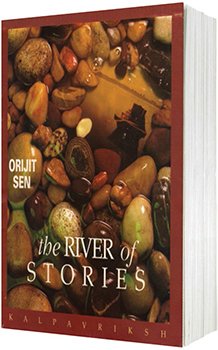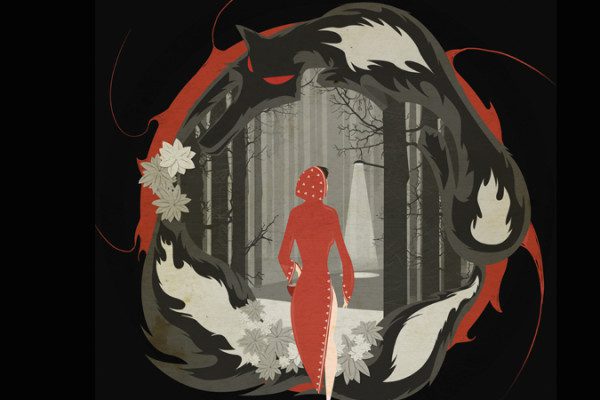From this month, a new column titled Backlisting. As the awards keep feting novels, here’s a column that celebrates the forgotten backlists of publishers… books and their lives, authors and their mindscapes. Part review, part conversation, part commentary. By Monidipa Mondal. This month, we go graphic with Orijit Sen’s River of Stories.
River of Stories
By Orijit Sen
Publisher: Kalpavriksh, 1994
Orijit Sen sits at his desk in an inner room of his sprawling and chaotic studio upstairs from the People Tree store in Hauz Khas Village. Inside a wooden bookcase at one corner of this room lives the only physical copy of River of Stories I know. It is tattered and discoloured, with the gum on the spine dried up and several of the pages come loose. This is not the copy I had read. As a young student in Calcutta six or seven years ago, I had downloaded the book in a CBR file from a torrent site I can no longer locate. When I mention this to Sen, he is not displeased. For the past many years, anyone who comes looking for River of Stories to the older People Tree store in Connaught Place is allowed to take a printout of the pages. The book has been out of print since its first publication in 1994.
Graphic novels in India have a chequered and not very long history. The medium came into widespread appreciation only after the publication of Sarnath Banerjee’s Corridor in 2004 by Penguin Books India. It was around the time when people started asking about River of Stories again, Sen tells me, but when he wrote and published the book—more than ten years before—there was little awareness and lesser to look forward to. The sixty-two-page-long book was a labour of love, written and illustrated over three years at Sen’s own expense—a leap considerably large for a comics creator, for the production process is more entwined with the creation of a comic book than it is with text. Art supplies and paper are expensive. Reimagining and drawing a panel is considerably more time- and labour-intensive than rewriting a paragraph in text. If factors such as page size, quality and texture of paper, whether the comic book would be in colour or in black and white are decided too late in the process, whatever has already been created may even need to be entirely discarded and recreated from scratch.
Fortunately for Sen, who was newly out of NID Ahmedabad and got interested in the Narmada Bachao Andolan around 1990, there were friends and others who understood his medium and as well as his vision. Through his participation in protests about the Narmada valley and his visits to the affected areas, he had befriended activist and musician Rahul Ram (key member of Indian Ocean, a band that would later produce the acclaimed hit Ma Rewa from a folk song of the Vindhyas) and his then wife Amita Baviskar, a sociologist who was researching the tribal myths of the Bhilala people of Madhya Pradesh, inhabitants of the area in which River of Stories is based. His friends arranged for Sen to receive a publishing grant via the environmental-issues’ NGO Kalpavriksh—a government grant that went into the making of a book supporting an anti-government protest, Sen chuckles in reminiscence. With the grant he went out to find a printing press. His budget did not allow printing in colour but Sen insisted on using a particular kind of thick semi-glossy paper which the press he selected happened to have at that time. The size of the paper decided the page size of the book—at 8-by-11 8 x10inches, slightly smaller than an A4-sized page—and its quality lent crispness and detail to the black-and-white art, which Sen put to efficient use all through. The lettering was done by hand by Baviskar.
River of Stories is a succinct and visually sumptuous work on the subject of the Narmada Bachao Andolan. Vishnu, a young journalist from Delhi, goes on a journey to Ballanpur to do a story on the reactions of the protesters and the locals, following a road that Sen himself may have taken. Interspersed with the narrative of Vishnu is the story of Malgu Gayan and the birth of the river Narmada (known locally and in the book as Rewa)—soft grey and pencil-shaded, as opposed to the fluid, cartoonish quality of the Vishnu strand of the story—rendering each panel like a painting. The two narratives come together as the story progresses, and so do the two styles of art. This technique is not entirely unprecedented, but Sen’s use of it in River of Stories receives significance from the fact that the Narmada Bachao Andolan questioned a development model that prescribed the replacement of age-old—and till then quite independent and self-sustaining—tribal cultures with large-scale modern structures for agriculture and industrialization. When Malgu Gayan of myth steps into Vishnu’s world, the transition is seamless not only due to Sen’s mastery of his medium, but also because the adivasis of the Narmada valley are still largely similar in both attire and perspective about the world.
Elsewhere in the book, in an overwhelming three-page-long pullout, Sen—who considers the double spread the basic unit of a comic-book story—depicts the course of the river Narmada from its source in Ambarkhant to the Rewasagar dam under construction, a map that transcends the topographical and becomes, as he calls it, ‘a map of stories told and as yet untold’. The map is superscripted with stories spoken in many voices, from Malgu Gayan singing the creation myth of the river on his rangai to the adivasis protesting in Hindi and urban activists explaining the ecological and humanitarian consequences of the dam-building projects.
After having printed River of Stories, Orijit Sen went around bookstores in Delhi trying to distribute it. He was met with baffled questions—was it a book for children? Why was the spine so thin? Even the bookstores that hesitantly agreed to sell the book would accept no more than five or ten copies. A few hundred copies were kept by Kalpavriksh to be sold at its events, but the rest of the stock remained with Sen, to be sold over the next five or six years from his independent People Tree store. “My friends and the people at Kalpavriksh loved it,” says Sen, “but at that time there was no impact on the media or the general public at all.” The author Khushwant Singh— who was sent a copy of the book, enjoyed it and invited Sen for a chat afterwards—was the only one who covered it in the media when he mentioned it briefly in his column in the Hindustan Times. Reader responses were few and far between, but also sometimes charmingly unexpected—for instance, a letter Sen received from a schoolteacher in Ethiopia who had somehow landed a copy of the book. It wasn’t until ten years later, with the rise in interest in graphic novels following Corridor, that Amitabh Kumar—fellow comics creator and a member of the Pao Collective, a comics ensemble started by Sen and a few others—made a scan of the only remaining copy of River of Stories and put it up online, the file that had made its way to my hands.
Back in the 1990s, though, the only substantial return from River of Stories was a WHO-and-NACO commission Sen received to put together a comics anthology about AIDS awareness in Manipur three years later. Lack of funding kept him from creating other longer works, but he continued to make short pieces in his own time, including a series of one-page shorts called Telling Tales for the India Magazine. The greater part of his years, however, had been occupied in establishing People Tree, which now has two branches in Delhi and one in Goa. Today, as both the store and the Pao Collective have caught the interest of a receptive public, Sen intends to republish River of Stories with a new prologue for the Pao Reader in 2014. (The first book from the collective, called the Pao Anthology, was published by Penguin Books India in 2012.) Reverberating with his distinct creative sense in both story and art, one hopes this will bring greater appreciation to non-fiction comics creation in India.



















Amit
Surprising that you don’t mention the Khedut Mazdoor Chetana Sangat and it’s activists who introduced him to the villagers of Alirajpur where he stayed। The role of KMCS and it’s activists, especially in Bhitada village, was Central to the making of this icononic book।
It is usual to forget the villagers in most middleclass writing but this shouldn’t happen with orijit’s work, who himself is quite particular about acknowledging the role of commoners।
Ujwal
I’ve had this page bookmarked for the better part of seven years. Where can I get a copy? Are they permanently out of print?
sumit
What a fascinating journey through the history and impact of “River of Stories”! It’s incredible to hear about Orijit Sen’s dedication to the art form and his journey in bringing such a meaningful narrative to life. Looking forward to more insights from your column on overlooked literary gems!
Seema
It’s fascinating how River of Stories continues to find its way to readers despite being out of print. Orijit Sen’s openness to sharing it speaks volumes about its significance. Hopefully, it gets a proper reprint someday!
Reena
What a beautifully written and deeply insightful piece! River of Stories isn’t just a graphic novel—it’s a cultural milestone and a visual archive of resistance, memory, and myth. Mimi Mondal’s tribute through this column resurrects a forgotten gem and reminds us how powerful storytelling can be—especially in unconventional forms like Sen’s work.
River of Stories isn’t just a graphic novel—it’s a cultural milestone and a visual archive of resistance, memory, and myth. Mimi Mondal’s tribute through this column resurrects a forgotten gem and reminds us how powerful storytelling can be—especially in unconventional forms like Sen’s work.